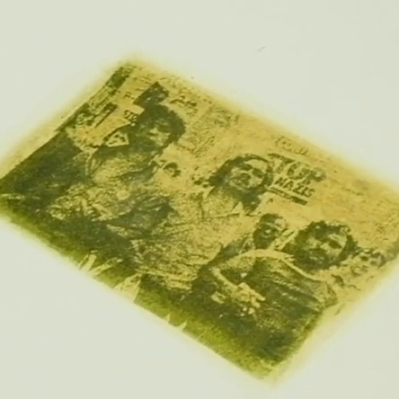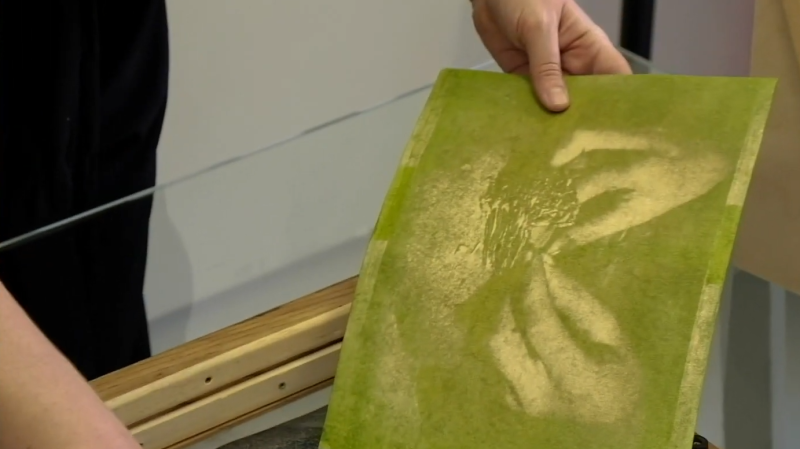Some people like spinach in their salads. Others would prefer it if it never gets near their fork. Still, other folks, like [Almudena Romero], use it for printing pictures, and they’re the folks we’ll focus on today.
Anthotypes are positive images made from plant dyes that fade from light exposure. Imagine you stain your shirt at a picnic and leave it in the sun with a fork covering part of the stain. When you come back, the stain not sheltered by cutlery is gone, but now you have a permanent fork shape logo made from aunt Bev’s BBQ sauce. The science behind this type of printmaking is beautifully covered in the video below the break. You see, some plant dyes are not suitable for light bleaching, and fewer still if you are not patient since stains like blueberry can take a month in the sun.
 The video shows how to make your own plant dye, which has possibilities outside of anthotype printing. Since the dye fades in sunlight, it can be a temporary paint, or you could use samples all over your garden to find which parts get lots of sunlight since the most exposed swatches will be faded the most. Think of a low-tech UV meter with logging, but it runs on spinach.
The video shows how to make your own plant dye, which has possibilities outside of anthotype printing. Since the dye fades in sunlight, it can be a temporary paint, or you could use samples all over your garden to find which parts get lots of sunlight since the most exposed swatches will be faded the most. Think of a low-tech UV meter with logging, but it runs on spinach.
If the science doesn’t intrigue you, the artistic possibilities are equally cool. All the pictures have a one-of-a-kind, wabi-sabi flare. You take your favorite photo, make it monochrome, print it on a transparent plastic sheet, and the ink will shield the dye and expose the rest. We just gave you a tip about finding the sunniest spot outdoors, so get staining.
Anthotype printing shares some similarities with etch-resist in circuit board printing processes, but maybe someone can remix spinach prints with laser exposure!
















Guess it’s how Popeye made his pix of Olive Oil.
It’s a re-leaf someone wanted to start the food puns. XD
This is magic! I need to try it.
If different plants dyes fade at different rates could you make colour prints by using dyes with both different colours and fade times?
Humm, good question. The slowest fading ones can be the first one to expose. Then apply a coating of the intermediate color, and expose that one. The fast fading is the last one, and those shorter exposures should not influence the slower dyes much.
However, one layer may obscure the other layers, not really mixing the colors. I guess you could make a kind of offset system for it, if you wanna go all out.
Yea, that’s what I was thinking, it would be an interesting experiment anway.
OK, this wasn’t what I thought it would be.
There’s already an organic photographic process: coffee-based developer.
http://www.wikihow.com/Develop-Film-With-Coffee-and-Washing-Soda
But that just develops regular black-and-white film, so you can process your film outside of a lab. Coffee isn’t actually photosensitive itself. This actually is a low-tech, plant based photosensitive material. Makes you think about whether the ancients could have invented photography if given the right clues.
(Actually, it partially WAS invented, at least in shadow outline form. It had been noticed by the 1700s that some silver compounds got darker with light. Film is still silver-based. Trouble is even if you make an image, it will keep darkening to black if you take it out of the box and into the light to see it. The last ingredient were additional chemicals to “fix” it and stop that process–something this process is also missing.)
So, you print photo on transparency, to make photo..we need to go deeper.
A fun experiment to try with the kids but not a lot of use given the image cannot be made colour fast. You can use a simple paper chromatography set-up to separate some pigments from all of the other organic gunk in the solution. Works with alcohol extracts of purple cabbage pigment, anthocyanins.
Are we sure it can’t be color fast? Darker colors absorb more light, perhaps a strong enough light could carbonize the dark parts. Perhaps a magnifying glass and welding goggles could be used.
Or, maybe there is some solvent which will wash off the parts that have already been exposed.
Or maybe there is some mordant that can be applied which will slow down the fading process somewhat.
Or maybe the method is more interesting on wood than paper. Spray it on an old fence and see if you get interesting patterns from the shadows different plants cast?
No it cannot be colourfast only mineral pigments can do that. With the exception of your carbonisation concept, but then you are talking about a setup that is so elaborate that the use of plant dyes is pointless to achieve the end result as their are more direct methods. It is low tech and ephemeral, we just have to accept that. So perhaps on unbleached paper used in biodegradable packaging it is “useful”., or in a work of art that is about that phenomena of impermanence? So more performance art than and artifact.
Now it’s time for spinach holograms!
This is really cool. I am definitely trying this out, perhaps with a picture of Popeye.
I did a bit of googling about it and find people who forgo the paper and the bending, and they just expose an actual lead like a (very slow) photographic plate. Very cool.
but can it detect explosives?